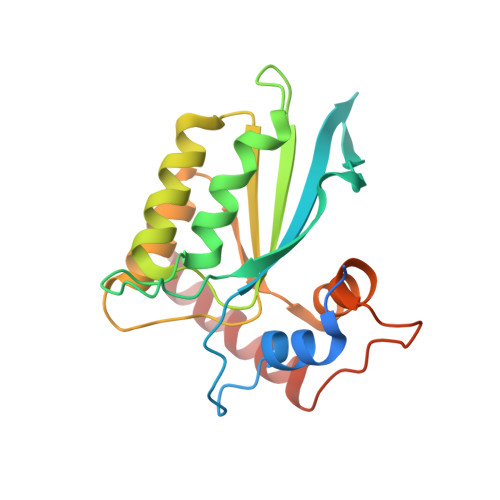First-In-Class Small Molecule Inhibitors of the Single-Strand DNA Cytosine Deaminase APOBEC3G.
Li, M., Shandilya, S.M., Carpenter, M.A., Rathore, A., Brown, W.L., Perkins, A.L., Harki, D.A., Solberg, J., Hook, D.J., Pandey, K.K., Parniak, M.A., Johnson, J.R., Krogan, N.J., Somasundaran, M., Ali, A., Schiffer, C.A., Harris, R.S.(2012) ACS Chem Biol 7: 506-517
- PubMed: 22181350
- DOI: https://doi.org/10.1021/cb200440y
- Primary Citation of Related Structures:
3V4J, 3V4K - PubMed Abstract:
APOBEC3G is a single-stranded DNA cytosine deaminase that comprises part of the innate immune response to viruses and transposons. Although APOBEC3G is the prototype for understanding the larger mammalian polynucleotide deaminase family, no specific chemical inhibitors exist to modulate its activity. High-throughput screening identified 34 compounds that inhibit APOBEC3G catalytic activity. Twenty of 34 small molecules contained catechol moieties, which are known to be sulfhydryl reactive following oxidation to the orthoquinone. Located proximal to the active site, C321 was identified as the binding site for the inhibitors by a combination of mutational screening, structural analysis, and mass spectrometry. Bulkier substitutions C321-to-L, F, Y, or W mimicked chemical inhibition. A strong specificity for APOBEC3G was evident, as most compounds failed to inhibit the related APOBEC3A enzyme or the unrelated enzymes E. coli uracil DNA glycosylase, HIV-1 RNase H, or HIV-1 integrase. Partial, but not complete, sensitivity could be conferred to APOBEC3A by introducing the entire C321 loop from APOBEC3G. Thus, a structural model is presented in which the mechanism of inhibition is both specific and competitive, by binding a pocket adjacent to the APOBEC3G active site, reacting with C321, and blocking access to substrate DNA cytosines.
- Department of Biochemistry, Molecular Biology & Biophysics, Institute for Molecular Virology, Center for Genome Engineering, University of Minnesota, 321 Church Street SE, Minneapolis, Minnesota 55455, United States.
Organizational Affiliation:



















